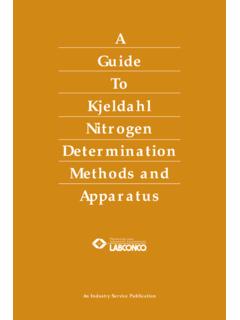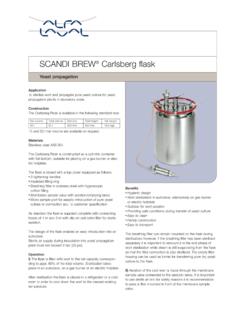Transcription of A Guide To Kjeldahl Nitrogen Determination Methods and ...
1 A. Guide To Kjeldahl Nitrogen Determination Methods and Apparatus An Industry Service Publication For more information, please contact us: ExpotechUSA. 10700 Rockley Road Houston, Texas 77099. USA. 281-496-0900 [voice]. 281-496-0400 [fax]. E-mail: Website: Forward This booklet has been developed to serve as a technical companion in the selection and use of Kjeldahl Nitrogen Determination Methods and apparatus. This material has been prepared with the help of Kjeldahl chemists, consul- tants and Labconco engineers. It will not teach you to perform the Kjeldahl procedure but will help you understand steps in the process. This generic presentation is designed to help educate persons unfamiliar with Kjeldahl methodology and answer frequently asked questions raised by Kjeldahl users.
2 History Nitrogen Determination has a long history in the area of The Digestion Process analytical chemistry. Johan Kjeldahl first introduced the Kjeldahl Nitrogen method in 1883 at a meeting of the Danish A general equation for the digestion Chemical Society. As chairman of the chemistry department of an organic sample is shown below as of the Carlsberg Laboratorium near Copenhagen, Kjeldahl one basic example: was assigned to scientifically observe the processes involved in beer making. While studying proteins during malt produc- tion, he developed a method of determining Nitrogen content Organic N + H2SO4 . that was faster and more accurate than any method available (NH4)2SO4 + H2O + CO2 + other sample matrix by-products at the time. His method used simple equipment and could be performed by an inexperienced technician.
3 A number of interrelated digestion conditions determine the rate of reaction and the completeness of the breakdown Applications of Nitrogen to ammonium sulfate. Among these are heat input to the acid digestion mixture, amount of inorganic salt Since 1883, the Kjeldahl method has gained wide added to elevate the acid boiling temperature, reflux rate of acceptance and is now used for a variety of applications. H2SO4 in the neck of the digestion flask, length of digestion, Kjeldahl Nitrogen determinations are performed on food and and catalyst addition. Adjusting any one of these factors has beverages, meat, feed, grain, waste water, soil and many an influence on the others. Proper digestion conditions for a other samples. The method has been refined and tested for a given sample matrix are achieved through establishing a bal- wide variety of substances and approved by various scientific ance of these factors in a controlled and repeatable fashion.
4 Associations including: In addition, if the sample contains nitrate or nitrite Nitrogen , it is possible to chemically pretreat the digest to include or AOAC International (formerly the Association of Official exclude this Nitrogen source from the analysis as desired in a Analytical Chemists) particular situation. Association of American Cereal Chemists Acid Considerations American Oil Chemists Society Sulfuric acid has been used alone for the digestion of Environmental Protection Agency organic samples. (As a convenience to reduce bumping of International Standards Organization the digestion mixture, Alundum boiling chips or pumice are United States Department of Agriculture often added.) The amount of acid required is influenced by sample size and relative amount of carbon and hydrogen in the sample, as well as amount of Nitrogen .
5 A very fatty sample What is the Kjeldahl method? consumes more acid. Also, heat input and digestion length influences the amount of acid loss due to vaporization during The Kjeldahl method is a means of determining the the digestion process. Remember that a Kjeldahl flask is Nitrogen content of organic and inorganic substances. essentially a bulb with a condenser neck off to the side for Although the technique and apparatus have been altered refluxing of the acid. considerably over the past 100 years, the basic principles introduced by Johan Kjeldahl endure today. The Kjeldahl method may be broken down into three Heat Input and Digestion Length main steps: Digestion - the decomposition of Nitrogen in organic Typically the heating elements used for Kjeldahl diges- tions have variable settings.
6 Heat input is frequently specified samples utilizing a concentrated acid solution. This is as that setting which brings 250 ml of water at 25 C to a accomplished by boiling a homogeneous sample in rolling boil in 5 minutes.. concentrated sulfuric acid. The end result is an Initially an organic sample usually chars and blackens. ammonium sulfate solution. The reaction may at first be very vigorous depending on the Distillation - adding excess base to the acid digestion matrix and the heat input. With organic decomposition the mixture to convert NH4+ to NH3, followed by boiling digestion mixture gradually clears as CO2 evolves. Metallic and condensation of the NH3 gas in a receiving solution. ions might tint the clear digestion mixture. Note that solution Titration - to quantify the amount of ammonia in the clearing in itself is not an indication that all organic Nitrogen receiving solution.
7 Has been broken down. Digestion length must be determined by recovery studies on known materials of similar matrix if a The amount of Nitrogen in a sample can be calculated new method is being developed. from the quantified amount of ammonia ions in the receiving solution. 3. Salt Additions recovery. Salicylic acid followed by sodium thiosulfate has been used to pretreat the mixture to ensure complete reduc- The problem with using sulfuric acid alone for diges- tion. Other reduction schemes have been devised. Or other tion is very long digestion times result with many samples pretreatments have been used to prevent nitrates from being due to the slow rate of organic decomposition. The addition reduced at all during the charring process, leaving a clear of an inorganic salt to the digest elevates the boiling point of digest with no contribution from nitrate ions.
8 The H2SO4. The solution temperature of concentrated sulfuric acid alone is about 330 C. Addition of a salt such as K2SO4. can elevate the solution temperature of the digestion mixture The Distillation to 390 C or more, depending on the ratio of salt to acid. Process This significantly increases the rate of organic decomposition in the digestion mixture, shortening the length of time The acid digestion mixture is diluted required for digestion. and made strongly alkaline with NaOH, There are several precautions to keep in mind con- liberating NH3 as follows: cerning salt addition. First, it is possible to raise the solution temperature of the digestion mixture too much. If the tem- ammonium ammonia perature goes much above 400 C during any phase of the sulfate heat gas digestion, volatile Nitrogen compounds may be lost to the atmosphere.
9 (NH 4 ) 2 SO 4 + 2 NaOH 2NH 3 + Na 2 SO 4 + 2H 2 O. Remember that as acid is gradually consumed during The Kjeldahl flask is attached to a water condenser and the digestion process, for the various reasons mentioned is heated to boil off the NH3 gas from the digest. The tip of above, the salt acid ratio of the digest gradually rises. This the condenser is submerged in a flask of acidic receiving means that the hottest solution temperatures are attained at solution, either standard acid or boric acid solution, to again the end of the digestion. Heat input, consumption of acid by trap the distilled NH3 in receiving solution. organic material and vaporization, salt/acid ratio, digestion length, and physical design of the Kjeldahl flask, are all interre- Digestion Mixture Dilution lated.
10 Each has an effect on the final solution temperature. A second precaution is that if the salt/acid ratio is too The acid digestion mixture is usually cooled and diluted high, a considerable amount of material will salt out upon with ammonia-free water. As mentioned above, with digestion cooling of the digest. Concentrated acid pockets can be con- mixtures containing high salt/acid ratios, dilution prevents or tained within the cake. These can react violently when con- minimizes caking. Sometimes this is done while the digestion centrated base is added in the distillation process. A certain mixture is still quite warm (with caution!), and the K2SO4 has amount of salting out can be managed by diluting the digest not yet salted out. With some digestion mixtures, a cake with water while it is still somewhat warm, but not too hot.



